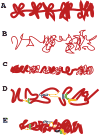Revisiting higher-order and large-scale chromatin organization
- PMID: 22459407
- PMCID: PMC3372662
- DOI: 10.1016/j.ceb.2012.03.003
Revisiting higher-order and large-scale chromatin organization
Abstract
The past several years has seen increasing appreciation for plasticity of higher-level chromatin folding. Four distinct '30nm' chromatin fiber structures have been identified, while new in situ imaging approaches have questioned the universality of 30nm chromatin fibers as building blocks for chromosome folding in vivo. 3C-based approaches have provided a non-microscopic, genomic approach to investigating chromosome folding while uncovering a plethora of long-distance cis interactions difficult to accommodate in traditional hierarchical chromatin folding models. Recent microscopy based studies have suggested complex topologies co-existing within linear interphase chromosome structures. These results call for a reappraisal of traditional models of higher-level chromatin folding.
Copyright © 2012 Elsevier Ltd. All rights reserved.
Figures


References
-
- Emanuel M, Radja NH, Henriksson A, Schiessel H. The physics behind the larger scale organization of DNA in eukaryotes. Physical biology. 2009;6:025008. - PubMed
-
- Grigoryev SA, Arya G, Correll S, Woodcock CL, Schlick T. Evidence for heteromorphic chromatin fibers from analysis of nucleosome interactions. Proceedings of the National Academy of Sciences of the United States of America. 2009;106:13317–13322. Combined experimental and theoretical approaches support the idea of features corresponding to both solenoid and zig-zag models for 30 nm higher order chromatin structure co-existing within single fibers as studied with reconstituted oligonucleosome arrays. A novel formaldehyde, electron microscopy based assay is used to examine preferential internucleosome interactions within these fibers which differ depending on the model. - PMC - PubMed
-
- Schalch T, Duda S, Sargent DF, Richmond TJ. X-ray structure of a tetranucleosome and its implications for the chromatin fibre. Nature. 2005;436:138–141. - PubMed
-
- Dorigo B, Schalch T, Kulangara A, Duda S, Schroeder RR, Richmond TJ. Nucleosome arrays reveal the two-start organization of the chromatin fiber. Science. 2004;306:1571–1573. - PubMed
Publication types
MeSH terms
Substances
Grants and funding
LinkOut - more resources
Full Text Sources
Miscellaneous

